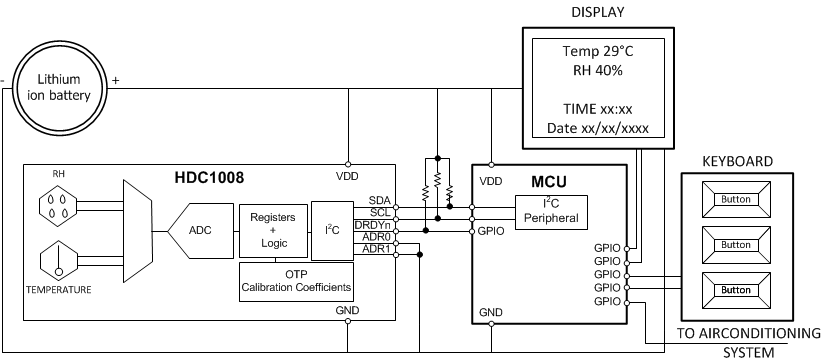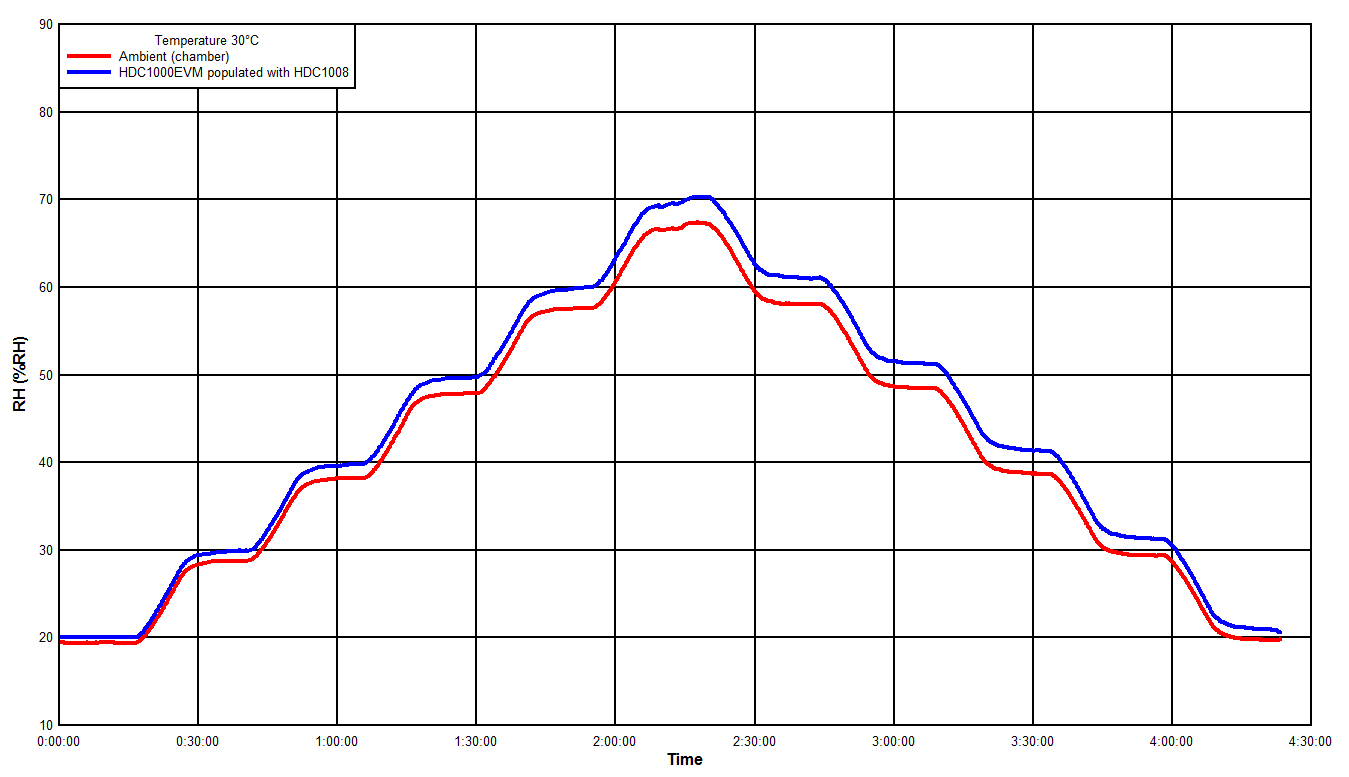SNAS649B October 2014 – December 2015 HDC1008
PRODUCTION DATA.
- 1 Features
- 2 Applications
- 3 Description
- 4 Typical Application
- 5 Revision History
- 6 Pin Configuration and Functions
- 7 Specifications
- 8 Detailed Description
- 9 Application and Implementation
- 10Power Supply Recommendations
- 11Layout
- 12Device and Documentation Support
- 13Mechanical, Packaging, and Orderable Information
Package Options
Mechanical Data (Package|Pins)
- YPA|8
Thermal pad, mechanical data (Package|Pins)
Orderable Information
9 Application and Implementation
NOTE
Information in the following applications sections is not part of the TI component specification, and TI does not warrant its accuracy or completeness. TI’s customers are responsible for determining suitability of components for their purposes. Customers should validate and test their design implementation to confirm system functionality.
9.1 Application Information
A HVAC or Thermostat are based on environmental sensors and a micro-controller which acquires data from humidity sensors and temperature sensors and controls the heating/cooling system. The collected data are then showed on a display that can be easily controlled by the micro controller. Based on data from the humidity and temperature sensor, the heating/cooling system then maintains the environment at customer-defined preferred conditions.
9.2 Typical Application
In a battery-powered HVAC or thermostat, one of the key parameters in the selection of components is the power consumption. The HDC1008, with its 1.2μA of current consumption (average consumption over 1s for RH and Temperature measurements) in conjunction with an MSP430 represents an excellent choice for the low power consumption, which extends the battery life. A system block diagram of a battery powered HVAC or Thermostat is shown in Figure 15.
 Figure 15. Typical Application Schematic HVAC
Figure 15. Typical Application Schematic HVAC
9.2.1 Design Requirements
In order to correctly sense the ambient temperature and humidity, the HDC1008 should be positioned away from heat sources on the PCB. Generally, it should not be close to the LCD and battery. Moreover, to minimize any self-heating of the HDC1008 it is recommended to acquire at a maximum sample rate of 1sps (RH + Temp). In home systems, humidity and the temperature monitoring rates of less than 1sps (even 0.5sps or 0.2sps) can be still effective.
9.2.2 Detailed Design Procedure
When a circuit board layout is created from the schematic shown in Figure 15, a small circuit board is possible. The accuracy of a RH and temperature measurement depends on the sensor accuracy and the setup of the sensing system. The HDC1008 samples relative humidity and temperature in its immediate environment, it is therefore important that the local conditions at the sensor match the monitored environment. Use one or more openings in the physical cover of the HVAC to obtain a good airflow even in static conditions. Refer to the layout below (Figure 19) for a PCB layout which minimizes the thermal mass of the PCB in the region of the HDC1008, which can improve measurement response time and accuracy.
9.2.3 Application Curve
The data showed below have been acquired with the HDC1000EVM populated with HDC1008 . The environment conditions have been evaluated in a humidity chamber.

9.3 Do's and Don'ts
9.3.1 Soldering
For soldering HDC1008, standard reflow soldering ovens may be used. The sensor is qualified to withstand soldering profile according to IPC/JEDEC J-STD-020 with peak temperatures at 260 °C. Refer to the document SNVA009 for more details on the DSBGA package. In the document refer to DSBGA package with bump size 0.5mm pitch and 0.32mm diameter.
When soldering the HDC1008 it is mandatory to use no-clean solder paste and no board wash shall be applied. The HDC1008 should be limited to a single IR reflow and no rework is recommended.
9.3.2 Hydration Procedure
The HDC1008 may exhibit a negative RH offset due to either the thermal stress of soldering or settling of the RH sensor. It will slowly settle when the humidity sensor is exposed to ambient conditions. If faster settling is required, the following hydration process can be used:
Store the PCB containing the HDC1008 at 85% RH and 85 °C for 12 hours.
9.3.3 Chemical Exposure
The humidity sensor is not a standard IC and therefore should not be exposed to volatile chemicals such as solvents or other organic compounds. If any type of protective coating must be applied to the circuit board, the sensor must be protected during the coating process.